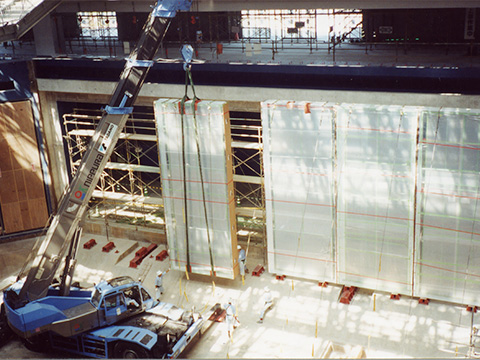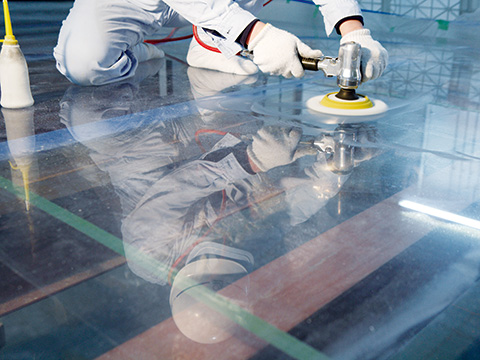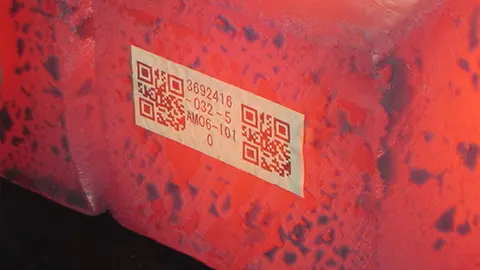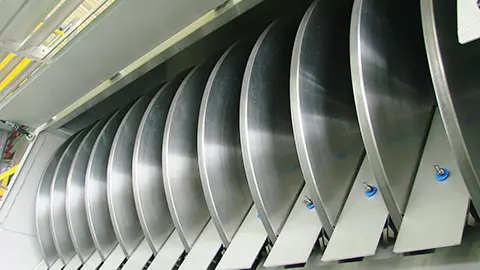VOL.194 JULY 2024
JAPANESE SMALL AND MEDIUM ENTERPRISES LEADING THE WORLD
A Giant Acrylic Aquarium Created with Four Exceptional Techniques

The Kuroshio Sea tank at Okinawa Churaumi Aquarium features a large acrylic panel for viewing.
Photo: NIPPURA
NIPPURA Co., Ltd., based in Kagawa Prefecture, makes the most of the characteristics of acrylic plates, the ease of processing and transparency, to develop techniques for creating huge aquariums. And the company is using the techniques to expand its business both domestically and internationally. They have repeatedly set records for the world’s largest exhibition aquariums in terms of water volume.
Often referred to as “one of the world's leading aquarium nations*,” Japan boasts numerous notable aquariums, with Okinawa Churaumi Aquarium in Okinawa Prefecture standing out as a top recommendation. One of its highlights is The Kuroshio Sea (10m deep, 35m wide, 27m long). This massive tank features approximately 70 species of fish, including several meters-long whale sharks and manta rays. The aquarium holds an impressive 7,500 tons of water.
This acrylic aquarium is a flagship project in Japan designed and constructed by NIPPURA Co., Ltd. The acrylic panels are an impressive 60cm thick. With such thickness, acrylic panels tend to exhibit a yellowish tint due to their natural color, but these panels maintain their transparency without losing clarity.
One reason for this is in the material preparation. President and Representative Director of NIPPURA, SHIKIYAMA Yasuhiro, explains, “We commission the production of the raw acrylic panels to a major comprehensive chemical manufacturer. To achieve transparency like crystal glass, we deliberately add special colors at this stage.”
Furthermore, ensuring safety and durability is highly important. To prevent incidents like cracks in public facilities or premature aging compared to buildings, acrylic aquariums must meet these two performance criteria, even on a massive scale.
NIPPURA achieves this through four exceptional techniques: cutting, bonding, polishing, and heat treatment.
The first technique, cutting, involves machining the raw acrylic panels to achieve a uniform thickness. When specifying the finished accuracy to the manufacturer commissioned for panel production, costs can escalate. To control costs, NIPPURA manages the process of ensuring uniform thickness in-house.
The second technique is bonding. The standard sizes for panels are 3.5m × 8.5m, available in thicknesses of 30mm and 40mm. These are laminated or joined together using specially developed high-strength adhesives produced in-house.

Photo: NIPPURA
The third step is extremely important for enhancing transparency: polishing. In this process, employees rely on their senses of sight and touch to manually polish the surfaces. It was concluded after trial and error that manual labor is best suited for ensuring the quality of special-order products.

Photo: NIPPURA
The fourth step, heat treatment, involves applying vibrations to the molecules of acrylic resin and adhesives to strengthen their bonds. This process significantly enhances the transparency and strength of the panels. By heating the acrylic resin until just before softening, the vibrations between molecules are maximized, and returning to room temperature ensures a highly uniform molecular bonding state. These exceptional techniques have gained international recognition, with a track record spanning over 400 projects across 63 countries in design and construction.

Photo: NIPPURA
As SHIKIYAMA passionately states, “Our acrylic aquariums represent Japan’s finest products. Moving forward, we will continue to uphold our dedication and cherish our pride in craftsmanship.”
* There is a research report stating that Japan has the highest number of aquariums per square kilometer in the world. In addition to aquariums certified under Japan’s Museum Act, there are numerous related facilities of various sizes, highlighting the advanced breeding techniques in the country.
By MOTEGI Shunsuke
Photo: NIPPURA

